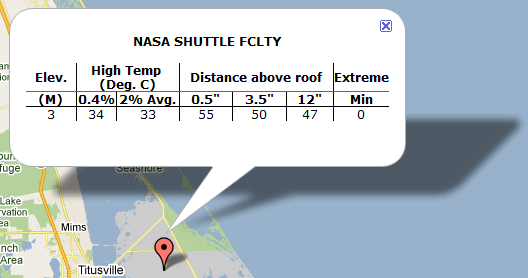This interactive solar reference map is intended to provide quick and intuitive access to weather data needed to install code-compliant PV systems.
NOTE: This page uses outdated ASHRAE weather data. We are working to get the data updated and permissions from ASHRAE.
How do I use this map?
Pan and zoom the map, you should see some red pins indicating the locations of weather stations. Click on a pin and you'll see something like this appear:

Choose a pinned location on the map that is most similar in climate to the PV system installation location. This may not be the closest geographical location to the installation since elevation and coastal proximity may have a greater impact on climate than regional proximity.
The following tables indicate low and high ambient design temperatures that must be used when designing code-compliant PV systems. These temperatures have been provided by ASHRAE, and are given in degrees Celsius. The high temperatures are used for conductor sizing and calculations of minimum array operating voltage. The low temperatures are used in the NEC 690.7 calculation.
There are several numbers listed for each site. A description of each number follows:
Elev.: the elevation in meters of the meteorological site.
High Temp (0.4%): this air temperature is only exceeded during 3 hours (not necessarily continuous) of a summer month (June through August). This number is slightly more conservative than the 2% value.
High Temp (2%): this number is likely exceeded during 14 hours (not necessarily continuous) over a summer month (June through August). The Copper Development Association recommends that this number be used for ampacity calculations.
Distance above roof: The high temperature numbers refer only to the air temperature. According to the National Electrical Code, the temperature within rooftop raceways shall be assumed higher than ambient; these temperatures are dependent upon the minimum height of that conduit above the roof (NEC 2008 Table 310.15(B)(2)(c), or NEC 2011 Table 310.15(B)(3) (c)). The three figures here (0.5", 3.5", 12") are based off the High Temp (2%) numbers. Conduit that touches the roof, or is less than 0.5" above the roof is not listed since it is poor practice to mount conduit this close to the roof in general.
Extreme Min: The lowest expected ambient temperature for this site. This number should be used for the calculations for maximum system voltage required in NEC 690.7.
[Last updated: 4/28/2023]